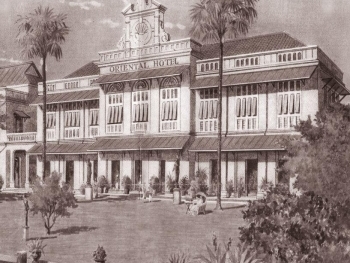Museums have long been guardians of history, art, and culture, but in recent years, technology has transformed the way people experience them. From augmented reality (AR) tours to AI-powered curators, modern innovations are making museums more immersive, interactive, and accessible than ever before.
In this article, we’ll explore how cutting-edge technologies like virtual reality (VR), artificial intelligence (AI), 3D scanning, and digital storytelling are revolutionizing museums and shaping the future of cultural heritage.
1. Virtual Reality (VR) and Augmented Reality (AR): Bringing Exhibits to Life
How It Works:
-
Virtual Reality (VR) creates fully immersive digital environments where visitors can "step into" historical events or famous artworks.
-
Augmented Reality (AR) overlays digital information on real-world objects, allowing visitors to see animated reconstructions, historical details, or hidden layers of an exhibit.
Real-World Examples:
🎨 The Louvre, Paris – Offers an AR-powered "Mona Lisa: Beyond the Glass" experience, allowing visitors to explore da Vinci’s techniques in detail.
🏺 The British Museum, London – Uses AR to digitally reconstruct ancient artifacts, letting visitors see how they looked centuries ago.
🏛 The Smithsonian, Washington D.C. – Features VR experiences that take users back in time, such as a 3D reconstruction of ancient Egypt.
Why It’s Revolutionary:
-
Allows remote visitors to experience museum collections from anywhere in the world.
-
Makes history more engaging by turning static exhibits into interactive experiences.
-
Helps museums preserve fragile artifacts by displaying them digitally.
2. AI-Powered Museum Guides: Personalized and Interactive Tours
How It Works:
-
Museums are using artificial intelligence (AI) to create chatbots and smart guides that provide instant, personalized information to visitors.
-
AI can analyze visitor behavior and suggest exhibits based on their interests.
Real-World Examples:
🤖 The Hermitage Museum, Russia – Uses an AI-powered virtual guide that answers visitor questions about artworks.
📱 The Prado Museum, Spain – Offers a personalized AI tour app that suggests exhibits based on the visitor’s preferences.
🖼 The National Gallery, London – Uses AI to recognize paintings through smartphones and provide real-time information.
Why It’s Revolutionary:
-
Allows for self-guided, customizable tours based on individual interests.
-
Helps visitors access instant translations, making museums more inclusive.
-
Reduces the need for human tour guides, making visits more flexible.
3. 3D Scanning and Printing: Preserving Cultural Heritage
How It Works:
-
3D scanning captures detailed images of artifacts, creating digital replicas that can be explored online.
-
3D printing allows museums to create physical replicas of fragile or lost artifacts for hands-on exploration.
Real-World Examples:
🏛 The Pergamon Museum, Germany – Uses 3D scanning to create digital models of ancient ruins.
🌍 The Smithsonian Institution, USA – Has an entire 3D digitization lab that scans artifacts to preserve them in case of damage.
🏺 The Egyptian Museum, Cairo – Uses 3D printing to recreate broken statues and missing pieces of artifacts.
Why It’s Revolutionary:
-
Helps preserve historical artifacts that are deteriorating over time.
-
Enables museums to replicate delicate objects for hands-on learning.
-
Allows global access to rare artifacts through digital archives.
4. Digital Storytelling and Interactive Displays
How It Works:
-
Museums are replacing traditional plaques with touchscreens, multimedia presentations, and immersive storytelling to make exhibits more engaging.
-
AI-powered interactive displays allow visitors to ask questions and receive dynamic responses.
Real-World Examples:
🎥 The Anne Frank House, Netherlands – Uses digital projections and multimedia storytelling to bring Anne’s diary to life.
💡 The Museum of the Future, Dubai – Features AI-powered exhibits that react to visitors' movements and choices.
🎭 The Museum of Modern Art (MoMA), New York – Uses digital storytelling to explain how artworks evolved over time.
Why It’s Revolutionary:
-
Transforms static exhibits into engaging, dynamic experiences.
-
Helps visitors understand complex historical events through visual storytelling.
-
Appeals to younger audiences by integrating familiar digital technologies.
5. Blockchain and NFTs: The Future of Digital Art and Ownership
How It Works:
-
Blockchain technology is being used to authenticate and track the history of digital and physical artworks.
-
NFTs (Non-Fungible Tokens) allow museums to digitally preserve and monetize artworks in a new way.
Real-World Examples:
🎨 The Uffizi Gallery, Italy – Has sold NFT versions of famous works like Michelangelo’s Doni Tondo.
🖼 The Hermitage Museum, Russia – Created NFT versions of classic artworks, offering digital ownership rights.
💾 The British Museum, London – Launched a collection of NFTs featuring Hokusai’s famous woodblock prints.
Why It’s Revolutionary:
-
Protects digital art from forgery by creating verifiable ownership records.
-
Allows museums to generate revenue from digital artwork sales.
-
Expands museum collections into the digital world, attracting new audiences.
6. Smart Museums: The Rise of IoT and Big Data
How It Works:
-
Internet of Things (IoT) sensors monitor museum conditions, ensuring proper temperature and humidity for artifact preservation.
-
Big Data analytics help museums understand visitor preferences and improve exhibit layouts.
Real-World Examples:
🏛 The Metropolitan Museum of Art (The Met), New York – Uses IoT sensors to monitor the environment around delicate paintings.
🎭 The Van Gogh Museum, Amsterdam – Analyzes visitor movement patterns to reduce overcrowding and improve exhibit placement.
📊 The Louvre, Paris – Uses AI and Big Data to create personalized museum routes for visitors.
Why It’s Revolutionary:
-
Helps museums protect fragile artifacts with real-time monitoring.
-
Enhances visitor experience by reducing wait times and overcrowding.
-
Provides museums with valuable insights into visitor interests and behavior.
The Future of Museums: Where Technology is Taking Us
With rapid advancements in VR, AI, 3D printing, blockchain, and IoT, the museum experience is evolving like never before. In the future, we can expect:
✅ Fully virtual museums accessible from anywhere.
✅ AI-powered holograms of historical figures giving personal tours.
✅ Smart exhibits that change based on visitor preferences.
✅ Augmented reality reconstruction of ancient cities.
As museums continue to embrace technology, they are breaking barriers, making history more accessible, and ensuring cultural preservation for future generations.



